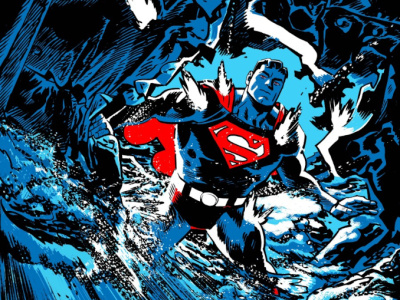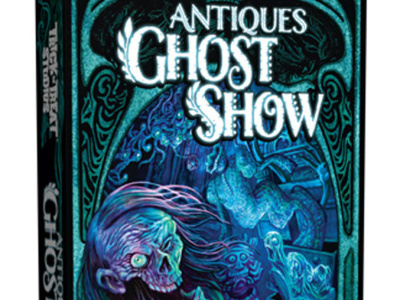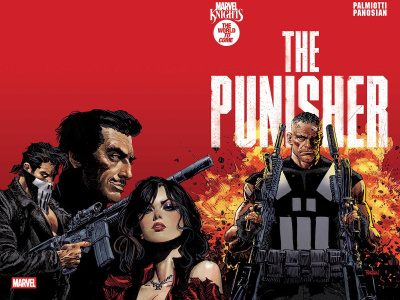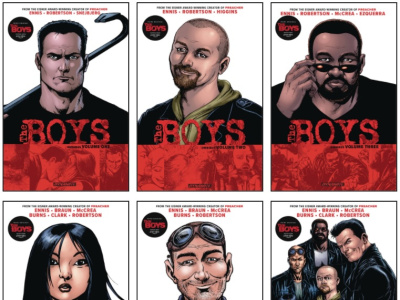 ICv2’s in-depth interview with IDW Publishing CEO Ted Adams kicks off with an overview of the market and IDW’s place in it, including market conditions, the demographic breadth of readers, how IDW is better at books without Borders, IDW’s high-end strategy, how digital event comics can be marketed better than print, and the digital share of IDW’s business. In Part 2, ICv2’s interview continues with a look at IDW’s media projects currently in development and its licensed books. And in Part 3, ICv2’s interview wraps up with a look at the possibility that IDW will grow by acquisition, a look ahead to the rest of 2013 for IDW, and a consideration of the risks of growth.
ICv2’s in-depth interview with IDW Publishing CEO Ted Adams kicks off with an overview of the market and IDW’s place in it, including market conditions, the demographic breadth of readers, how IDW is better at books without Borders, IDW’s high-end strategy, how digital event comics can be marketed better than print, and the digital share of IDW’s business. In Part 2, ICv2’s interview continues with a look at IDW’s media projects currently in development and its licensed books. And in Part 3, ICv2’s interview wraps up with a look at the possibility that IDW will grow by acquisition, a look ahead to the rest of 2013 for IDW, and a consideration of the risks of growth.What’s your view of the state of the comics industry?
My view is that it’s amazing. It’s a terrific time to be a comic book publisher. We’ve seen dramatic increases in quarter to quarter and year to year sales in all channels of distribution--direct market, book market, specialty market and digital publishing. And last year was a good year, so it’s not like it’s up from a bad year. Last year was a terrific year.
What do you attribute that to?
There are a lot of really good books out. What I like about the market today is that it’s not a speculator-driven market. We don’t have any books that are selling a million copies; we have lots of books that are selling reasonable amounts of copies. The books are good, and that’s bringing people into stores and causing people to find them on their various reading devices.
We like to look at demographic concentration or breadth. We’ve had some times the last 15 years when there’s been great breadth--when manga brought in a lot of girls, for example. What are your thoughts on the question of who’s buying comics?
Looking at us specifically, if you look at the success we’ve had with My Little Pony since we launched last November, it’s extraordinary. That’s a comic that has performed in every channel; the direct market has done gangbusters with it. The first issue’s probably at the fifth or six printing. The e-book sales, both in the apps and iBook store have been incredible. The number of books that we’ve sold in the ebook format have been astonishing with My Little Pony, and we have a big order from Scholastic. It’s going to be in Scholastic book clubs and book fairs this fall.
Clearly that’s a book that’s not aimed at what you would think of as your traditional comic book customer. It’s not a comic book intended for guys in their 30s and 40s. Just looking at us alone, it shows that there’s a much more diverse customer base for our product that there was 12 months ago or a couple of years ago.
You said it’s not directed at males in their 30s and 40s, but isn’t that who’s buying it?
Certainly there’s a little bit of that, there’s no question that there’s an older fan base for Ponies. There are also lots of kids reading those books. The Scholastic purchase is 100% going to kids. My suspicion is that the eBooks are going to kids; the direct market sales are driven somewhat from the older audience. We also hear a lot that guys are buying it for their kids and kids are coming in and discovering it on their own.
We’re two years out from the collapse of Borders and things have settled down. What do you see in the book store channel?
Same there, the book channel is up significantly for us. It’s up an astonishing amount from what it was two years ago. Part of that is due to the collapse of Borders and the shrinking book market, but we’re seeing it as a much healthier book market.
The book market used to make me crazy on this returnable basis basically forever. That was never a sustainable business model. Where we are today is we are able to sell product in a reasonable way so that the bookstores get a chance to sell the product and we don’t get these giant returns. So we are a much more efficient book channel publisher than we were two years ago, and because of that, much more profitable than we were two years ago.
You said sales are up as well?
Yes, sales are up. Year to year sales are up significantly. Part of it is because we went through that big contraction that happened because of Borders, and that’s starting to come back now. It’s no secret that Amazon has become a very significant buyer of graphic novels and they buy in a very efficient way. They don’t purchase the way Borders used to purchase.
Is part of the reason that you’re more efficient in that channel that one of the least efficient players dropped out?
Absolutely. Our business is significantly better because Borders is no longer around.
You’ve expanded your focus on the higher end collector in the last year with the launch of the limited editions on top of the Artist’s Editions. Can you talk about IDW’s activities in that part of the market?
It really started when we got into Library of American Comics-- really nice, hardcover books with a retail price in the $50 range. What we found is that if you produce a good product, the price point almost becomes secondary. It’s going back to the quality driving the renewed interest in comics. If you’re putting out a really high quality product, the price point doesn’t become as scary for the consumer. So with Library of American Comics, we discovered that the $40 and $50 price point was not a stumbling block for us to be able to bring products to market.
We initially intended Artist’s Editions as a direct-to-consumer product, not because we wanted to cut out the direct market, but the books are extremely expensive to print and it was difficult to do the margin you need to make it work at the comic stores. Once we launched with the Rocketeer Artist’s Edition, we had overwhelming demand from the direct market to figure out a way to sell the products through them. The direct market is, and always will be, our most important channel, so when they speak, we listen. We figured out a way to distribute those through the direct market in a way that still worked for us, and again, found that the $100 and $125 price point worked. Because the books are so good, the consumer is willing to open their checkbook or take out their credit card to buy those books.
I’ve always been a consumer of really nice signed and numbered limited editions, books from places like Subterranean Press, Cemetery Dance and Gauntlet Press. Those folks are typically direct-to-consumer sales, I suspect for the same reasons: the books have a high cost of goods for the printing and it’s tough to sell through traditional distribution and margin. So I clearly saw there was a market for high end books. The sticker price was not off-putting for a certain segment of our marketplace, so we launched our IDW Limited business last year. The idea is that these are extremely high end books; they are at a minimum signed and numbered, they come in really nice gravity boxes, in some cases they have original pieces of art in the books themselves. These are really high value items aimed at a pretty small segment of the audience who’s going to want that highly collectible item.
We launched with a couple of Transformers books and a Teenage Mutant Ninja Turtles book and had a great response to them. Then we started to hear from the direct market that these were books they would also like to offer to their customers. We’ve since figured out how to do something similar to what we did with the Artist’s Editions where now the IDW Limited books are available through the direct market through Previews just like the rest of our products.
On the other end of the spectrum from those collectible objects is digital, where there is no object. How is IDW doing with digital these days?
Digital continues to see explosive growth for us. I’m kind of a broken record on when we speak every year, but our digital sales just continue to expand on a quarterly and annual basis at a rate that I, frankly, didn’t think was possible. And again, it’s not coming at the expense of our print books. Our print business is also up substantially in that same time period. It’s very clearly not coming at the expense of the print books.
You could also make the argument, and I do make this argument fairly frequently, that there is some number of people who are rediscovering comics on their iPads and that’s causing them to go back to the comics stores. Ultimately comics are a really physical medium and people want those physical products.
What I like about ebooks is that it allows us to market event comics in a way that’s tough for us to do in the direct market. I can give you a specific example. The Star Trek movie came out a few weeks ago, and we had comics that lead directly into the movie written by one of the guys who wrote the movie. These are very canon-focused prequel comics that lead into the movie, and then this week, we had a comic coming out that’s a sequel to the movie, that tells events that happened right after the movie. Again, all canon, co-written by one of the guys that wrote the movie. That message is frankly tough to communicate to the direct market in a way that reaches the consumer level, whereas in the ebook channel, I wouldn’t say it’s easy, but you can actually have that communication. The comiXology app has the opportunities to do bricks that make it very clear that this Star Trek content leads into the movie you just saw in theaters. It’s the same thing if you look in the iBook store, the Kindle Store and on Amazon.com proper. Our Star Trek apps talk all about it.
Where ebooks shine is that opportunity to communicate a message very clearly to the consumer. It’s tough to communicate that message in the same way through the direct market. It’s not to say that we don’t love the direct market because we love the direct market above all else, and they do everything else in an amazing way, but that ability to communicate a message to the consumer can be accomplished better and easier through ebooks.
Is that a new thing to have storyline before and after a movie?
We did the prequel to the first movie and then we did eventually do some sequels. All of our ongoing Star Trek comics have been sequels to the first movie, but this is the first time we’ve been able to time it so perfectly where the sequel happened two weeks after the movie hit theaters.
What’s the share of digital for your business?
In the last six months, it’s about 15% of our direct market revenue. The last time we spoke it was about 10% of our direct market revenue. And to reiterate, that’s with a dramatic increase in our direct market revenue during that the same time period.
Click here to go to Part 2, for a look at IDW’s media projects currently in development and its licensed books.







